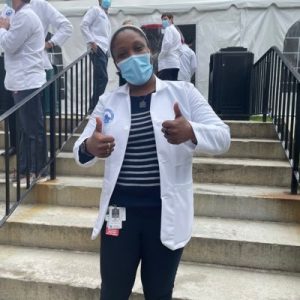Takeaway
I was able to help my incarcerated brother understand the benefits of COVID vaccination. He appreciated my input and became an advocate to convince other inmates. Much was learned about interacting with those who are vaccine hesitant—read the piece for my pearls.

Lifelong Learning in Clinical Excellence | September 20, 2021 | 3 min read
By Imani McElroy, MD, MPH, Mass General
The interruption of the automated voice reminding us that the call was being recorded forced Darius to take a breath. As I listened to him recap his efforts to get his fellow inmates vaccinated, I could hear the familiar frustration in his voice. “Man sis, I’m really trying to educate them!” He sighed.
“I know D. You just have to be patient. Persistent. But patient,” I replied into the phone.
The pandemic has been a life-changing experience for everyone. However, having a sibling incarcerated during this time has given me a unique look into the experience of imprisoned populations. At the peak of the pandemic, Darius and his cellmate spent 23 out of 24 hours confined to their six by eight-foot cell. In his letters, he described his daily “bird bath” and how he spent most of his time outside the cell waiting in line to call our mom. Each of his letters updated me on the rapidly rising number of positive cases in his prison. In each of my responses, I made sure to give him the most up to date information that I could about vaccine development and my own experiences once I received the vaccine. Like I did with many of my family members, I gently pushed for him to get vaccinated as soon as he was able. Darius managed to stay healthy through two separate outbreaks in two different facilities. Once he got his vaccine, he began encouraging his fellow inmates to do the same.
Since the vaccine was first announced, numerous articles have been written about vaccine hesitancy, especially within the African American population. The reason most often cited is the infamous CDC/US Public Health Service Syphilis Study performed at Tuskegee Institute. However, simplifying medical mistrust down to this study and centering it as a semi-isolated event is not only detrimental to current vaccine efforts, but also disrespectful to African American and other historically disenfranchised communities. Medical exploitation of vulnerable groups, such as African Americans and incarcerated individuals, are not isolated events of the past, and continue to breed mistrust of the healthcare system today. In my conversations with my brother, we’ve discussed the reasons his fellow inmates are hesitant, and I’ve provided counterarguments to help him educate them. The onus is on us as healthcare practitioners to be patient and persistent in our efforts to encourage vaccination with the understanding that many people have very valid reasons to be wary of medical institutions.
We cannot afford to get frustrated and give up in our efforts to increase vaccination rates. We have too much to lose at the hands of this pandemic if we do not persevere. Far too frequently have I heard the frustrated “Why bother?” come from colleagues as we grapple with the extended physical, mental, and emotional toll the pandemic is taking on us. I understand the feelings of resentment, however, there are still people that can be reached. For every person we can get vaccinated, they can then turn around and continue the efforts just as my brother has. This is the hard part of the vaccination push. Those that were going to get the vaccine no matter what have already done so. This is the part of the push that is going to take concerted and patient effort. We owe it to the individuals who have been excluded and/or harmed by the medical system to meet them where they are and work forward.
Here are few things that help me speak with patients about vaccine hesitancy:
1. Listen.
Actively listen to your patient and hear what’s making them hesitate. You can always take a moment after they finish talking to process and respond, but if you aren’t listening, you’ll probably miss something important.
2. Acknowledge the patient’s fears/misgivings and validate their previous experiences.
Communicate that you’re trying to understand their perspective and where they’re coming from. Meet them where they are.
3. Have an open mind and avoid judgement.
4. Leave the door open for future conversations.
You may not get to the end point of the conversation in one visit. Tell your patient you’re available for another discussion. Taking the time to revisit the topic may result in progress.
This piece expresses the views solely of the author. It does not represent the views of any organization, including Johns Hopkins Medicine.

